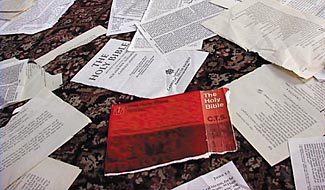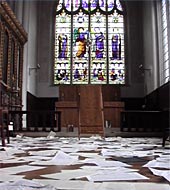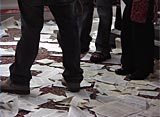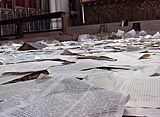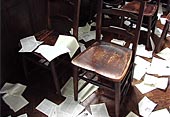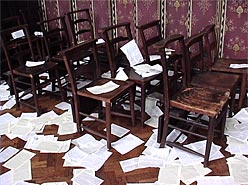Information and news around the world flooding from relatively old media such as TV, newspapers and radio are the most familiar two-dimentional reality in our everyday life. However, how many of us actually deal with those news stories with a sense of reality? Are we not ignoring them as "somebody else's business"?
One of the things with which I most strongly felt this sentiment of "somebody else's business" was the Iraq War. Triggered by September 11, armies from the US, UK, Japan and many more countries were sent out under a false cause. I have heard some of them are engaged in inhuman acts, forcing Iraqi people to deny Islam. Religion is still very much alive in the everyday life of Iraqi people. For human beings who have emotion, this psychological pain may have been a more painful torture than any physical one.
Having heard of these reprehensible incidents, one historical practice comes to my mind, especially as a Japanese: Fumie. Fumie (literally "stepping on a picture") was a means used in the Edo-period (17th - mid 19th century) to prove one was not a Christian. Specifically, one was forced to "step on" a statue or image of the Virgin Mary or of Jesus Christ - doing so meant that he or she could not have been a Christian, which was strictly prohibited in that era. For the Christians forced to preform Fumie the psychological pain must have been beyond description.
"Stepping on" is an attempt to posit our enlarged and abstracted reality as something tactile and tangible, treating that sentiment of "somebody else's business" ironically.
Firstly, with Fumie as an inspiration, a swapping of places is done. In other words, what is happening in Iraq is going to happen in a church. There, each page of a Bible is torn away and spread on the floor. Although there is still room for choice, it essentially means audiences have to step on the pages of the Bible. It might look like a straightforward criticism on Christianity, yet my interest did not lie there. It was focused upon replacing the unquestioned relationship between church and Bible within a different context and how this would affect the audiences internally. Furthermore, much attention was paid to treat the material (a Bible and church) not merely as physical entities, but as media that generate a web of relationships, creating a space where the audiences can respond on a physical level.
'Stepping on' the bible in the church is almost an equivalent of denying Islam in Iraq, and that means the audiences experience what is being done in Iraq with the sense of reality. However, that is only no more than an artificial reality. Despite its being virtual reality, the dialogue between the space and the audiences let them find out the relationship between the space and themselves, in other words, they discover 'my business', feeling reality.
I do not think people who experienced this installation directly associated it with what is happening in Iraq, yet I wonder how many of those who were disgusted by this were disgusted by abuses in Iraq with the same sense of reality.
The body never forgets the sensation of experiencing something. We might say what is important are tangible things, yet it is actually in those things intangible that there is something we can 'take away' from the experience. After leaving the location, changes within occur - changes that are truly important. How artistic activities remain in and affect others - that is precisely where art and artist's meaning of existence resides.
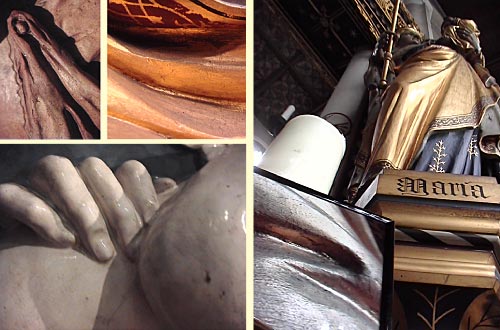
Another element of this work is an attempt to capture symbols of Christianity - statues of Virgin Mary and Jesus Christ - from a different perspective. With the help from the photographer Keisuke Ono, various parts of three statues in the church - parts that can be seen as erotic, or as having affinity with female genitals - are photographed and printed in extreme close ups, framed and distributed around the statues from which photographs were modelled. Furthermore, similar photographs were produced from statues in the Victoria and Albert Museum, similarly framed and exhibited on the floor.
The photographs generated quite a realistic eroticism, and some of them could not be looked at as nothing but what they mocked. Looking at sacred symbols of Christianity in such a way was obviously the most blasphemous thing to do, and one can easily imagine that the audiences were fairly disgusted. However, sexuality is something that everybody desires, and the most important desires for us, in the sense that it is necessary for the perpetuation of the species. That means, those photos were something very imprudent and something one wishes to look away from, while at the same time they were equally symbols of pleasure, inviting one to look. In other words, those statues were replaced with motherly symbols of the most important activity for all of us. What used to be symbols only for Christians were transformed into symbols for anybody.
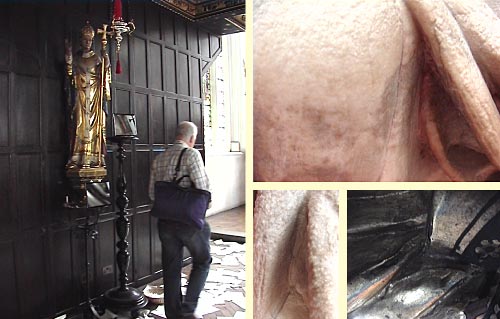
When September 11 happened, many artists around the world were feeling art might have lost its power completely.
In order to perform a fresh role in the society, how an artist can be a sensor, understanding and transmitting a rounded picture of a multi-layered entity that is called reality - this is where the meaning of an artist's existence lies.
In June 2004, every sort of mass media was exposing the false cause of the Iraq War. Michael Moore's 'Fahrenheit 911' was released and was fueling discussions. I feel that receiving an offer for an exhibition at such a time was not a mere coincidence. I do feel that having done this exhibition in the UK, where religion is still alive in everyday life, and at this historic St. Cyprian's Church, where remarkable people such as T.S. Eliot, Andrew Webber and so forth have come, was truly meaningful. Let us not forget that like the case of the US army, abuse of Iraqi people by the British army has also been reported.
August 2004 koichiro yamamoto
photo : Keisuke Ono
